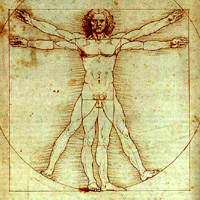The human body is symmetrically, but you won't call this symmetry. Do we need absolute symmetry? Hardly. In this case, our body would be too boring. But the excessive asymmetry is also ugly. Read more about symmetry and asymmetry Read the article.
Content
If the body can be conditionally divided in half along the median vertical line so that two halves are a mirror mapping of each other, then such a body can be considered completely symmetrical. If the two obtained halves are not a mirror mutual mapping, the body is asymmetrically.
The sphere is symmetrical when dividing it through the center in any direction. If there is only one plane, for example, passing through the length of the body, dividing along which two symmetric half can be obtained, such a symmetry is called two-sided. Many plants have several different symmetry lines, and bilateral symmetry is characteristic of many animals. The man, as mentioned above in the section on the right and left brain hemispheres, has an asymmetrical structure. This human body asymmetry can sometimes be very noticeable, and it is much more complicated than animals.
 Science does not yet give a response to the question, do we believe, people who initiate asymmetry inherent to us are actually beautiful or not. Some anthropologists claim that the degree of symmetry can never be excessive, and the person in the process of evolution acquired the knowledge that the high degree of symmetry testifies to strong health and good heredity. It is clear that significant disorders of symmetry in the structure of the body and face we do not consider attractive. However, there are evidence that small deviations from symmetry are considered beautiful. Full symmetry is pretty boring for brain and human eye. As an example of complete symmetry, you can imagine a completely white room with a white ceiling and white walls, without windows and doors. Similar absolutely symmetric environment is boring for visual perception. However, if you bring a certain proportion of asymmetry, for example, hanging a couple of paintings on the wall, it will create an interested aesthetic attitude. The same applies to our perception of other people. In order to illustrate this phenomenon, one American magazine conducted a small photographic experiment with several models known worldwide. Their photos were taken and a mirror image was obtained. Then the photos were cut on the halves and again made up the face by combining first two left, at then two right half. Both absolutely symmetrical faces obtained were clearly different from the original photograph of the present person with natural right and left half. The obtained absolutely symmetric photos were neither so beautiful, nor are the natural faces of the models.
Science does not yet give a response to the question, do we believe, people who initiate asymmetry inherent to us are actually beautiful or not. Some anthropologists claim that the degree of symmetry can never be excessive, and the person in the process of evolution acquired the knowledge that the high degree of symmetry testifies to strong health and good heredity. It is clear that significant disorders of symmetry in the structure of the body and face we do not consider attractive. However, there are evidence that small deviations from symmetry are considered beautiful. Full symmetry is pretty boring for brain and human eye. As an example of complete symmetry, you can imagine a completely white room with a white ceiling and white walls, without windows and doors. Similar absolutely symmetric environment is boring for visual perception. However, if you bring a certain proportion of asymmetry, for example, hanging a couple of paintings on the wall, it will create an interested aesthetic attitude. The same applies to our perception of other people. In order to illustrate this phenomenon, one American magazine conducted a small photographic experiment with several models known worldwide. Their photos were taken and a mirror image was obtained. Then the photos were cut on the halves and again made up the face by combining first two left, at then two right half. Both absolutely symmetrical faces obtained were clearly different from the original photograph of the present person with natural right and left half. The obtained absolutely symmetric photos were neither so beautiful, nor are the natural faces of the models.
Although these professional beauties have more symmetrical features of the face than most of us, they are always endowed with a certain attractive asymmetry.
Thus, we should not strive for complete symmetry. However, it is safe to say that our aesthetic feeling also hurts too strong asymmetry. If we turn again for example with a white room, then aesthetically we would be less pleasant to see the walls and the ceiling, to the failure filled with various objects of art. Strong asymmetry, such as the presence of one big breast and a small one, is usually considered inestic, and in such cases, the desire to achieve a more symmetrical appearance is quite natural. These considerations can serve as a guide when determining a suitable object for plastic surgery.









